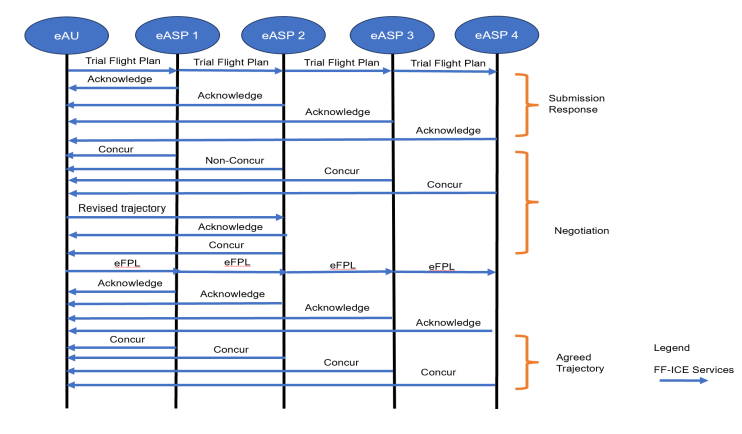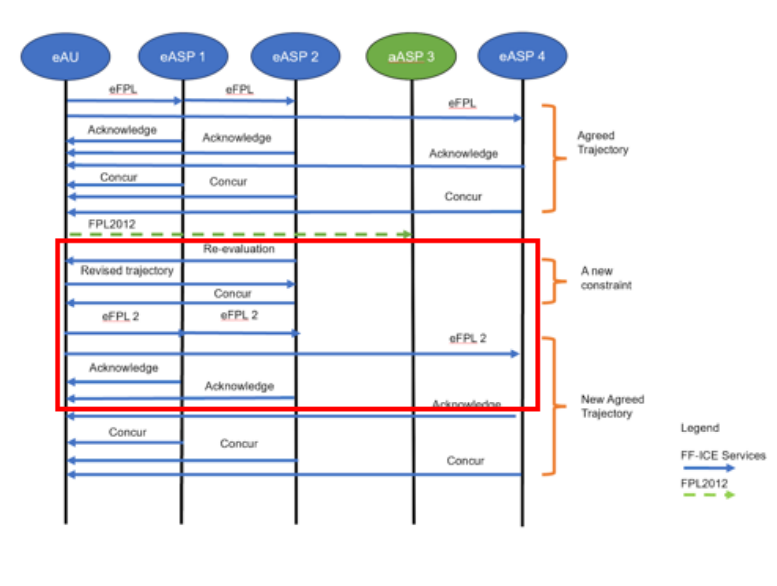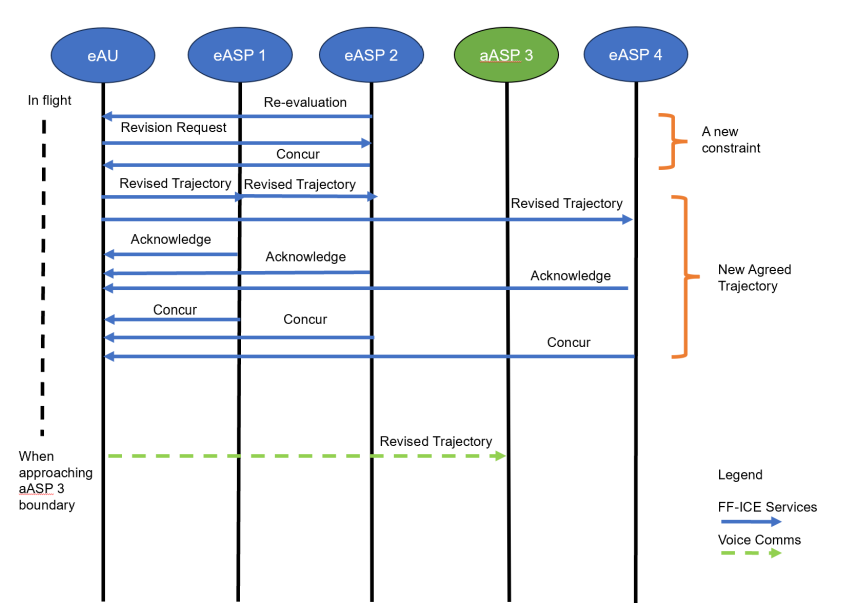65TH ANNUAL CONFERENCE, Abu Dhabi, 28 April – 2 May 2025WP No. 100Global Harmonisation in the Interaction Between ATM Stakeholders in a TBO Mixed-Mode OperationsPresented by TOC |
| SUMMARY There is a global push from ICAO for States to move towards TrajectoryBased Operations (TBO) implementation. However, due to different priorities and resource constraints, TBO would be implemented in phases, also known as mixed-mode operations. Different ATM stakeholders would be in varying degrees of capability readiness, and at different timelines, with both TBO enabled Airspace Users (eAU) and ATM Service Providers (eASP), as well as non TBO enabled Airspace Users (aAU) and Air Navigation Service Provider (aASP). The process of negotiating for an optimal flight trajectory in a mixed-mode operation can be confusing and add to ATC workload when the request is sent through multiple eASPs and aASPs. Thus, there needs to be a global harmonisation of the appropriate interaction between all the ATM stakeholders. |
Introduction
1.1. The Global Air Traffic Management Operational Concept (GATMOC), ICAO Doc 9854, presents the vision to achieve an interoperable global air navigation system that incorporates all Airspace Users (AUs) throughout their phases of flight, while meeting safety, economic, environmental and national security requirements.
1.2. To achieve this vision, it is essential to have global information utilisation and management in a safe, secured and timely manner. This supports the evolution towards a holistic, cooperative and collaborative decision-making environment. Within this environment the interests and expectations of ATM stakeholders are fairly managed, including interactions with other trajectories, constraints and hazards to achieve the optimum system outcome. This is the essence of TBO.
Discussion
2.1. TBO is an ATM operational concept to help strategically plan for and optimise a flight trajectory through enhanced data sharing, improving the predictability of aircraft movement and flight timings, flight efficiency, and increasing airspace utilisation. AUs would prefer to fly a specific trajectory to best meet their business interests (riding on the wind, away from weather, fuel efficiency, etc). Air Navigation Service Providers (ANSPs), referred to as ATM Service Providers (ASPs) in TBO operations, would want to be able to achieve the best management of air traffic flow within their Flight Information Regions (FIRs) to accommodate and optimise their available capacity.
2.2. In TBO operations, the AU’s intended flight trajectory is shared and negotiated among all the relevant ATM stakeholders (including ASPs, airport operators and Flight Operation Center) so that potential constraints such as bad weather, activation of Special Use Airspace (SUA), Air Traffic Flow Management (ATFM) measures, or aerodrome congestion can be made known early and the follow up ATM planning could take the constraints into consideration when there is trajectory negotiation.
2.3. For example, an AU can be made aware of a SUA activation that would be active two hours before departure, and the necessary trajectory adjustments can be made before departure to avoid the SUA and request for track shortening, enabling the AU to meet the required fuel efficiency and on time performance.
2.4. With the availability of earlier and more accurate flight data, ATFM can utilise the data to optimise traffic flow, allowing for better Demand and Capacity Balancing (DCB – one of the important GATMOC components to achieve TBO), avoiding traffic congestion and holding, thus reducing the ATCOs’ overload risk. The optimisation of a flight trajectory is an iterative, continuous process, automated with specific rules and regulations as defined by the eASP. With better data sharing and real-time communication, TBO will enhance situational awareness for both pilots and ATCOs, contributing to more efficient flight trajectories, higher safety standards and more effective conflict resolution.
ICAO Fourteenth Air Navigation Conference (AN-CONF/14)
2.5. At the recent ICAO AN-CONF/14, the conference presented several Working Papers (WPs) pushing for TBO implementation, upgrading of ATM systems to enhance data sharing and harmonising the TBO concept. This included WP/11 “Cessation of ICAO 2012 Flight Plan by 2034”, WP/41 “Phasing out legacy ATM Systems for enhanced efficiency and safety”, WP/48 “Towards harmonised realisation of the ICAO Global TBO Concept in the Asia-Pacific Region” and WP/60 “Enabling Successful Deployment of TBO”. (The WPs can be found in this link: https://www.icao.int/Meetings/anconf14/Pages/WP_Num.aspx)
2.6. In particular, the ICAO secretariat presented WP/11, which proposed a recommendation for the cessation of ICAO 2012 flight plan by 2034. The paper discussed about the difficulty of operating in a prolonged period of mixed-mode operations (A period of ATM operations involving ASPs and AUs operating via both FPL2012 and FF-ICE (Flight and Flow Information for a Collaborative Environment)), as it would incur additional resources to support both modes of flight planning (FPL 2012 and FF-ICE), which would conversely slow down the rate of implementation of TBO, possibly negating the expected benefits. This calls for urgent action to work towards the new flight planning services to enable TBO, with the appropriate guidance provided by ICAO and contributing bodies. This will be elaborated further below.
Present Day Mode of ATC Operations
2.7. In the Asia Pacific region, the flight plan of an aircraft is submitted once in FPL2012 format, and there is no acknowledgement of the flight plan received. After the appropriate schematic checks and validation by the receiving ANSP, the flight plan is taken as accepted unless the ANSP calls up the airline operator to enquire about certain errors in the flight plan. There is also no subsequent update to the flight plan if there are any new constraints such as an ad hoc activation of Danger Area, and the pilot must manage this after the departure of the flight with tactical ATC actions. While in flight, an aircraft may also be subjected to several tactical interventions by ATCOs, including change in altitude, speed and headings. An aircraft may be asked to speed up in one sector, only to be told to expect holding at the next sector. This creates unnecessary confusion and workload for both pilots and ATCOs.
2.8. As mentioned in para 2.6, ICAO AN-CONF/14 has endorsed the recommendation for the global cessation of FPL2012 by 2034. States and ANSPs are encouraged to work towards implementing the next generation of flight planning services, such as FF-ICE, to achieve TBO and prevent a prolonged mixed-mode operation, where the efficiency and safety of air traffic may be affected. This can be done with ICAO developing and maintaining a work programme to address the full scope of TBO.
FF-ICE Implementation in EUROPE
2.9. In Europe, the Commission Implementing Regulation (EU) 2021/116 (CP1, or Common Project One is a part of the Single European Sky ATM Research (SESAR) European regulation that sets out essential requirements for the implementation of air traffic management (ATM) functionalities to enhance the performance of the European aviation system) has mandated for IFR General Air Traffic (GAT) airspace users operating in the European Air Traffic Management Network (EATMN) airspace to start filing FF-ICE flight plans (including military GAT flights but excluding Operational Air Traffic flights) with the implementation target date of 31 Dec 2025. CP1 also applies to ANSPs that provide air traffic services at all area control centres within the EATMN and approach and aerodrome units for specific airports, and to the Network Manager (NM), as a provider of FF-ICE services.
2.10. Currently, the NM translates accepted FF-ICE submissions into FPL 2012 message structures for ANSPs who are not yet FF-ICE enabled. The NM offers translation and delivery of flight plans to recipients outside of the IFPZ (Integrated Initial Flight Plan Processing System Zone – a centralised service to handle the reception, initial processing and distribution of flight plan data for IFR flights operating within Europe) upon request by the AU. Translation services will continue as long as there are nonFF-ICE enabled ANSPs, supporting various FF-ICE services and processes.
FPL2012 vs FF-ICE
2.11. Flight planning in a TBO environment is enabled through System Wide Information Management (SWIM) and FF-ICE, which will take over FPL2012 as the new flight planning format. It is intended to cover all phases of a flight, from planning to execution and post-flight analysis. FF-ICE allows for more data rich exchanges, and it is designed to support more dynamic and flexible negotiation between all stakeholders in air traffic management, including airlines, air navigation service providers, and airport operators. SWIM provides a framework to enhance the exchange of information in ATM, shifting from traditional point-to-point communication model to an integrated, system-wide approach, to enable seamless and secure information sharing among stakeholders. A sample message exchange is illustrated in Diagram 1 below, between stakeholders who are all FF-ICE enabled.

Diagram 1: Sample of possible data exchange sequence between all FF-ICE enabled ATM stakeholders
TBO Mixed-Mode Operation
2.12. In a TBO mixed-mode operation, there exist stakeholders with different TBO capabilities. The process of negotiating for a trajectory can be confusing when the request is sent through different eASP and aASP. The appropriate interaction between all the relevant ATM stakeholders should be addressed so that the situation is at least equal, and preferably better than today. As mentioned in para 2.9, Europe has mandated the filing of FF-ICE flight plans by December 2025. Flights departing Europe might then find themselves in airspace where the ANSPs are not FF-ICE ready after leaving European airspace.
2.13. The work on FF-ICE/R2 (FF-ICE/R2 refers to FF-ICE message exchanges post-departure/inflight) is still in discussion at the ICAO ATM Requirements and Performance Panel (ATMRPP). As such, there may be differences in regional operations, dealing with FF-ICE enabled and non-enabled stakeholders. The rules and regulations from ICAO ATMRPP should provide clear guidelines and interim rules to ensure safety and efficiency during this transition period.
2.14. For example, in Diagram 2 below, if an eAU files a flight plan revision through eASP 2, but the trajectory affected is in aASP 3 and eASP 4, who should be the correct approving party, and who should be responsible to send the update of revised flight plan, in the correct format, to the other eASPs and aASP?

Diagram 2: Sample of possible Flight planning data exchange in a mixed mode environment
2.15. There can also be confusion on the interaction between AU and ASP in a TBO mixed-mode environment, especially in flight. This could happen when the eAU wants to file a trial flight plan or send a flight plan revision to a mix of eASP and aASP, as shown in Diagram 3 below. In mixed mode operations, it is also expected that the aASP would not be able to receive advance information of any trajectory changes.

Diagram 3: Sample of possible data exchange showing late notification of change in trajectory to aASP
2.16. Currently differences already exist in regional operations. For example, in Europe, the NM helps to coordinate and translate (provided by INDRA) for all the FPL2012 flight plans and eFPL coming in, while in the US, there is the Command Centre to help with this process. However, the Asia Pacific Region consists of many FIRs, with fragmented set of airspaces. It could be difficult to manage the different types of flight plans, as well as the interactions between the stakeholders. In the African region, the Agency for Aerial Navigation Safety in Africa and Madagascar (ASECNA), which is an organisation of 17 African countries, helps to handle the flight planning services, but it is not provided for the non-members.
2.17. Current TBO trials are focused on the interaction processes within their region. EUROCONTROL, China, US, and Asia-Pacific (APAC) have begun conducting regional trials and table-top exercises. At some stage, there should be some harmonisation of processes globally so that the pilots and ATCOs are not confused by the different operating procedures when an aircraft moves across different FIRs.
Existing IFATCA Policy
2.18. IFATCA TPM ATS 3.12 recommends the following:
IFATCA Policy is:Efforts should be undertaken to reduce existing Mixed Mode Operations by creating intrinsically safe solutions. Introductions of new Mixed Mode Operations should be avoided by creating intrinsically safe solutions. When safety of a Mixed Mode Operation cannot be completely managed at an intrinsic level, assessment shall take place to ensure that the change in the ATM system does not increase controller workload to an unacceptable level. |
2.18.1. The current policy captures the fundamental issue with Mixed Mode Operations. It must be recognised that Mixed Mode Operations would take place and should be managed accordingly. There would be changes to current work procedures and potentially increase in workload to accommodate the situation. However, policies should be in place to ensure that the increase in ATCO workload is not unreasonable, and appropriate training should be provided to ensure ATCOs are able to manage it appropriately. This policy may need future re-evaluation.
2.19. TOC is of the opinion that there is a need for a new stand-alone policy regarding responsibilities of the ATM stakeholders before implementing TBO, so that there will be less confusion moving forward. The proposed wording is:
Before implementing TBO, there should be a clear delineation of roles and responsibilities with regard to processing and interacting with the different flight plan formats, especially during mixed mode operations. Examples include the following:
- Updating revised trajectories to downstream ANSPs, regardless of their capability level.
- Interaction between different flight plan formats
Conclusion
3.1. When FPL2012 was forced into implementation, there was confusion and panic amongst the ANSPs, as everyone was rushing to meet the deadline. As such, FF-ICE implementation was intended to be done in phases to allow ANSPs more time to train and prepare their ATCOs to manage the change. However, this also creates the issues raised for the mixed mode operations.
3.2. Policies and standards should be set such that there is global harmonisation of procedures when the AU and ASP operate in mixed mode operations throughout different FIRs. There would be an expectation of similar rules, and the process should not be more complicated to coordinate than it is today. Differing procedures could add to the complexity and workload for both the ASP and AU.
Recommendations
4.1. It is recommended that new policy is added within the ATS section of the TPM as follows:
| IFATCA TPM (20XX), ATS 3.XX – |
| Proposal: Before implementing TBO, there should be a clear delineation of roles and responsibilities with regard to processing and interacting with the different flight plan formats, especially during mixed mode operations. Examples include the following: ● Updating revised trajectories to downstream ANSPs, regardless of their capability level. ● Interaction between different flight plan formats |
References
ICAO Global TBO Concept (Version 0.11) – Draft
ICAO Doc 9965 – Manual on Flight and Flow – Information for a Collaborative Environment (FF-ICE)
FF-ICE/R1 Implementation Guidance
ICAO Fourteen Air Navigation Conference WP/11 – Cessation of ICAO 2012 Flight Plan by 2034
ICAO Fourteen Air Navigation Conference WP/41 – Phasing Out Legacy Air Traffic Management Systems For Enhanced Efficiency And Safety
ICAO Fourteen Air Navigation Conference WP/48 – Towards Harmonized Realization of The ICAO Global Trajectory-Based Operations (TBO) Concept In The Asia-Pacific Region
ICAO Fourteen Air Navigation Conference WP/60 – Enabling Successful Deployment of Trajectory-Based Operations
ICAO Fourteen Air Navigation Conference Draft Report of The Committee On Agenda Item 4
EUROCONTROL FDFDE FF-ICE/R1 Mixed Mode Transition Operations


